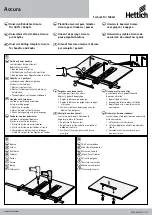
6 — English
Lock the switch trigger and remove the battery pack.
Grab the collar firmly and pull it away from the tool.
Rotate the ratchet head to your desired position.
NOTE:
The head can be set to 0
˚
, 90
˚
, 180
˚
, and 270
˚
.
Once the ratchet head is in one of the four indexed posi-
tions, the spring loaded collar will snap back into place.
LOCK OUT LEVER
See Figure 5, page 9.
The lock out lever reduces the possibility of accidental
starting. The lock out lever is located on the handle above
the switch trigger. The lock-lever must be in the unlocked
position before you pull the switch trigger. When not in use,
slide lock-lever down to lock the switch trigger.
VARIABLE SPEED SWITCH TRIGGER
See Figure 5, page 9.
The variable speed switch trigger delivers higher speed with
increased trigger pressure and lower speed with decreased
trigger pressure.
To turn the tool
ON
, move the lock out lever to the unlocked
position and depress the switch trigger. To turn it
OFF
,
release the switch trigger and allow the tool to come to a
complete stop.
NOTE:
A whistling or ringing noise coming from the switch
during use is a normal part of the switch function.
WARNING:
Battery tools are always in operating condition. Lock the
switch when not in use or carrying at your side, when in-
stalling or removing the battery pack, and when installing
or removing sockets.
LED LIGHTS
See Figure 5, page 9.
The LED lights near the collar illuminate when the switch
trigger is depressed.
If the tool is not in use, the time-out feature will cause the
light to start fading and then shut off.
The LED lights illuminate only when there is a charged bat-
tery pack in the tool.
INSTALLING AND REMOVING SOCKETS
See Figure 6, page 9.
Always select the correct size socket for nuts and bolts. Us-
ing the wrong size socket may damage the nut or bolt and
cause the fastening torque to be inaccurate or inconsistent.
Lock the switch trigger and remove the battery pack.
Push a 1/4 in. socket (not included) onto the anvil until
the detent pin locks it into place.
To remove the socket (not included), pull it away from the
anvil.
OPERATING THE RATCHET
See Figure 7, page 9.
WARNING:
Do not drive a bolt where there is likely to be hidden
wiring behind the surface. Contact with a “live” wire will
make exposed metal parts of the tool “live” and shock
the operator. If you must drive a bolt where hidden wire
could be present, always hold tool by insulated gripping
surfaces (handle) when performing the operation to pre-
vent a shock to the operator.
NOTICE:
The ratchet is not designed to be used as a drill.
Proper fastening torque is determined by the kind of bolt,
the size of the bolt, or the material of the workpiece. This
tool is designed only to speed the installation and removal
process and is not intended to replace a torque wrench. For
applications where proper torque is important, always use
a torque wrench to verify that proper torque is achieved.
NOTE:
Do not use this tool to install lug nuts on wheels.
Install the desired socket.
Adjust the forward/reverse dial on the back of the ratchet
head to choose the desired rotation direction of the
socket.
Hold the tool in front of the workpiece with the socket
over the nut or bolt.
Depress the switch trigger and fasten or loosen as
desired.
NOTE:
After fastening, always check the torque with a
torque wrench.
NOTICE:
Do not turn the tool off and attempt to use the tool
manually to gain extra torque on the nut or bolt being
tightened. Doing so could cause damage to the fastener
and/or the tool.
NOTE: MAINTENANCE INFORMATION BEGINS ON PAGE 7 AFTER FRENCH AND
SPANISH LANGUAGE SECTIONS. ILLUSTRATIONS START ON PAGE 8.
OPERATION






































